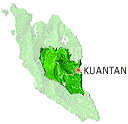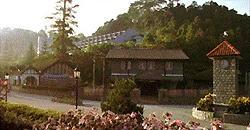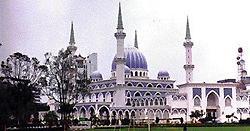![]() Johor
Johor
![]() Malacca
Malacca
![]() Negeri Sembilan
Negeri Sembilan
![]() Selangor
Selangor
![]() Perak
Perak
![]() Kedah
Kedah
![]() Perlis
Perlis
![]() Pahang
Pahang
![]() Terengganu
Terengganu
![]() Kelantan
Kelantan
![]() Penang
Penang
![]() Sabah
Sabah
![]() Sarawak
Sarawak
![]() Kuala Lumpur
Kuala Lumpur
![]() Labuan
Labuan
![]() Putrajaya
Putrajaya

 Mention Pahang
to a Malaysian, and he will probably conjure up visions of lush
tropical forests, cool mountain air, beaches, lakes and
waterfalls nestling in the arms of mountain crevices. The largest
state in peninsular Malaysia is, in many ways, one of its most
wild and Edenic. Two thirds of it is covered by unspoiled rain
forest.
Mention Pahang
to a Malaysian, and he will probably conjure up visions of lush
tropical forests, cool mountain air, beaches, lakes and
waterfalls nestling in the arms of mountain crevices. The largest
state in peninsular Malaysia is, in many ways, one of its most
wild and Edenic. Two thirds of it is covered by unspoiled rain
forest.
Visitors to Pahang are usually there to visit the state's famous hill resorts, its internationally-known islands and beaches, or Taman Negara, the Peninsula's finest park. Each of these attractions is substantial enough to merit special attention in our pages. Pahang's other attractions, though less well-known, should not be missed by anyone visiting the state
The natural heart of Pahang is unquestionably Taman Negara, Malaysia's oldest national park, lovingly referred to as "The Green Heart." Within the park is also the peninsula's highest point, the forest encrusted Gunung Tahan. Also in the interior are many of Malaysia's hill stations, mountain resorts where the tropical heat is kept at bay by the altitude. On the coast of Pahang, the jungle gives way to clean, palm-lined beaches, fishing villages, and the multicultural state capital, Kuantan.
Pahang is the largest state in
Peninsular Malaysia and is situated in the eastern coastal
region. The state's 35,964 sq. km encompasses a remarkable range
of Malaysia's many different environments, from the majestic
peaks and cool hill regions of the state's western region to the
miles of soft sand beach along the South China Sea. Pahang's
nearly one million people constitute a representative mix of
Malaysia's three main ethnic communities-- Malay, Chinese, and
Indian.
 Since early times, Pahang has come under the influence
of many regional powers. Pahang became a discrete political
entity during the Melaka Sultanate, when Raja Muhammad, the son
of Sultan Mansur Syah, was made its sultan in 1470. However,
throughout the 1500s, Pahang continued to be a vassal of Siam.
Following the downfall of Melaka, Johor-Riau superseded Melaka's
suzerainty over Pahang. Pahang became the fiefdom of Johor-Riau's
Bendaharas after Bugis attacks weakened the Johor-Riau Empire in
1795. A protracted civil war between self-proclaimed heirs and
siblings Wan Mutahir and Wan Ahmad (1858-63) led to Wan Ahmad's
victory and his ascension as Sultan. British interest in Pahang's
mineral resources forced Pahang to accept a British Resident.
J.P. Rodger was appointed as Pahang's first British Resident in
1888. Pahang became a Federated Malay State in 1896; this lasted
until the Japanese invasion. The British Military Administration
took over in September 1945. The British in London formed the
Malayan Peninsula Planning Unit in 1943, and on 10 October 1945,
the Malayan Union scheme was laid out before the British
Parliament. A day later, Sir Harold MacMichael was sent to the
Malayan Peninsula to obtain the agreement of the
Since early times, Pahang has come under the influence
of many regional powers. Pahang became a discrete political
entity during the Melaka Sultanate, when Raja Muhammad, the son
of Sultan Mansur Syah, was made its sultan in 1470. However,
throughout the 1500s, Pahang continued to be a vassal of Siam.
Following the downfall of Melaka, Johor-Riau superseded Melaka's
suzerainty over Pahang. Pahang became the fiefdom of Johor-Riau's
Bendaharas after Bugis attacks weakened the Johor-Riau Empire in
1795. A protracted civil war between self-proclaimed heirs and
siblings Wan Mutahir and Wan Ahmad (1858-63) led to Wan Ahmad's
victory and his ascension as Sultan. British interest in Pahang's
mineral resources forced Pahang to accept a British Resident.
J.P. Rodger was appointed as Pahang's first British Resident in
1888. Pahang became a Federated Malay State in 1896; this lasted
until the Japanese invasion. The British Military Administration
took over in September 1945. The British in London formed the
Malayan Peninsula Planning Unit in 1943, and on 10 October 1945,
the Malayan Union scheme was laid out before the British
Parliament. A day later, Sir Harold MacMichael was sent to the
Malayan Peninsula to obtain the agreement of the  Malay Rulers. According
to this agreement, Pulau Pinang, Melaka and nine other Malay
states were united under the Malayan Union. Malay opposition
derailed the Malayan Union plan, and the Malays under Dato' Onn
Jaafar's leadership formed the United Malays National
Organisation (UMNO) on 11 May 1946. The Malay Federation was
founded on 1 February 1948, the first step towards independence,
and on 31 August 1957, independence was achieved.
Malay Rulers. According
to this agreement, Pulau Pinang, Melaka and nine other Malay
states were united under the Malayan Union. Malay opposition
derailed the Malayan Union plan, and the Malays under Dato' Onn
Jaafar's leadership formed the United Malays National
Organisation (UMNO) on 11 May 1946. The Malay Federation was
founded on 1 February 1948, the first step towards independence,
and on 31 August 1957, independence was achieved.
There are more than 20 places of interest in Pahang, including resorts, historical buildings, caves and islands. Being the largest state in Peninsular Malaysia, it is home to Gunung Tahan, the highest peak in Peninsular Malaysia, and Taman Negara, Malaysia's largest national park. The main hill resorts, Fraser's Hill, Cameron Highlands and Genting Highlands, can also be found here. Pahang is also a shopper's paradise with its handicraft centres offering items like wood carvings, brocades, shellcraft, and batik cloth.
Tasik Chini
A hundred kilometers south of
Kuantan is Tasik Chini. The thirteen fresh-water lakes that make
up Tasik Chini are steeped in myths and mysteries, from the
requisite stories of monsters in the lakes to legends of an
ancient Khmer city on the site. Local stories assert that the
mythical city would escape attack by sinking into the lake. The
latter tale has attracted archaeologists to Tasik Chimi, and
structures have indeed been located on the bottom of the lake.
Even if such evocations of Loch Ness and Atlantis leave you cold,
the region's natural beauty is more than sufficient reason to
visit. Between August and September, pink and white lotus flowers
cover the surface of the water.
Kuantan
While the capital of Pahang is
of less historical interest than many of Malaysia's state
capitals, Kuantan is the entry point for many of Pahang's
peerless beach resorts.
Administrative Divisions
(Bera, Bentong, Cameron Highlands, Jerantut, Kuantan, Lipis,
Maran, Pekan, Raub, Rompin and Temerloh)
State Capital
Kuantan
Royal Town
Pekan
Population
1,231,176 (2000)
Breakdown of Races (1994)
Malays: 789,000
Chinese: 209,000
Indians: 67,000
Other Bumiputeras: 40,000
Others: 16,000
River
Sungai Pahang : 435 km (the longest River in Peninsular
Malaysia)
Highest Mountain:
Gunung Tahan 2187 m (the highest peak in Peninsular Malaysia)
Town & Infrastructure:
Islands & Beaches
Nature
Highlands
![]() States
States
![]() Tourism
Tourism
![]() National Symbols
National Symbols
![]() History
History
![]() Geography
Geography
![]() Flora & Fauna
Flora & Fauna
![]() Economy
Economy
![]() Culture
Culture
![]() Festivals
Festivals
![]() Transportation
Transportation
![]() Accommodation
Accommodation
![]() Foreign Exchange
Foreign Exchange
![]() Food
Food
![]() Fruits
Fruits